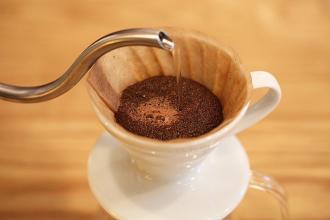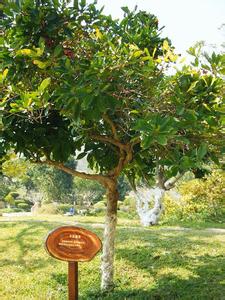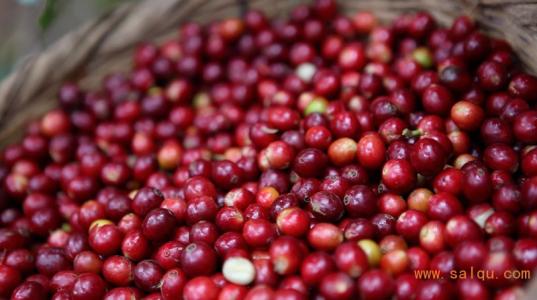Hand brewed coffee water powder proportion step diagram
Diagram of the proportion of gouache in hand-brewed coffee
Water temperature: boiling water into the cool hand pot is basically about 95 degrees, at this time to grind beans (I use electric mill, hand or grind first …... As DIMLAU said, 95 degrees starts steaming, and when you flush, the water in the pot can start to flush at about 90 degrees. Basically, the water temperature is always in the right state, and you don't have to worry about it without a thermometer.
Powder-water ratio: for those who are too lazy to understand the golden cup, please read the boldface directly. Citing the rule of the fool's version of the golden cup (temporarily based on the American version of the gold cup, based on the average concentration and average extraction rate of American black coffee drinkers' favorite range of nearly 10,000 random samples), the data is 1.15% to 1.35%, and the extraction rate is 18% to 22%. In the stupid version, then what can we control? The ratio of powder to water, the mid-point recommended brewing ratio of SCAA's golden cup rule is 1buzz 18.18SCAE midpoint 1RV 16.6666666, but due to the diversity of brewing methods, and when the roasting degree of modern boutique coffee is generally not deep (not easy to extract) or pay more attention to the extraction of sweet and sour front flavor (tend to low extraction rate). For example, the use of bypass (a large amount of powder extraction before the flavor is injected with water to the appropriate concentration), so the average extraction rate is not enough, so it is recommended to use 1:16 (1 g coffee powder corresponds to 16ml water). Under this powder-to-water ratio, the extraction rate is low and it is easier to reach a concentration of 1.15% to 1.35%.
The scale is right, but the brewing proportion is not right, and it is not easy to make delicious coffee. In the process of learning * *, we need to drink repeatedly and test the concentration. It is found that the best brewing ratio, that is, the amount of coffee beans is higher than that of black coffee, which is between 1: 12 and 1: 13, which is equivalent to the four major gold cup systems in Europe and the United States. the ratio of coffee beans to grams is 1: 14.5: 1: 15.5, and it is most likely to hit the golden range of 18% 22% and 1.5% of the extraction rate of "golden cup moment". Instead of brewing espresso with tangled flavor spectrum or thin coffee with too strong water flavor. It is believed that the brewing ratio of most hand-brewed coffee lovers should fall within this range. The most commonly used hand-brewing ratio in Chongqing is 1: 12: 1: 13, that is, 1: 14.5: 1: 1: 15.5 according to the Golden Cup Criterion. Of course, some hand-brewed coffee lovers use a more extreme brewing ratio. For example, those who like heavy flavors are often hand-brewed at 1:10 (that is, the golden cup ratio is 1-12. 5), using a higher concentration to make up for the deficiency of extraction, that is, only to extract low molecular weight and medium molecular weight sour and sweet flavors to avoid extraction of high molecular weight bitter substances, although it can also make mellow delicious coffee, but the concentration is too high, it is not easy for ordinary people to accept. Moreover, it is a waste of coffee powder and should not be encouraged. In fact, good and mellow coffee can be made at a more normal 1:12 (that is, a golden cup ratio of 1mm). Interestingly, there are also some light coffee lovers who like to brew by hand in a diluted proportion below 1:14, but do not underestimate these coffee lovers, whose taste buds may be sharper and can be appreciated in a variety of layers from the thinner coffee liquid. If you have to use 1:10 to brew in order to feel good enough, it may be that the sense of taste is too dull and depends on high concentrations to stimulate it.

Important Notice :
前街咖啡 FrontStreet Coffee has moved to new addredd:
FrontStreet Coffee Address: 315,Donghua East Road,GuangZhou
Tel:020 38364473
- Prev

How many years can coffee trees be planted before they have commercial value-how can coffee trees be planted in China
How many years can coffee trees be planted in China? coffee trees can only grow in the tropics and subtropics. Coffee trees can grow in different climates, soils, elevations and rainfall in the middle of the coffee belt. Coffee trees thrive in the hot and humid canyons and forest rainforests of Africa; they still produce high quality in cold, foggy, windy Central America.
- Next

What is the caffeine content of normal espresso? A brief introduction to flavor description and taste
What is the caffeine content of normal espresso? A brief introduction to flavor description and taste caffeine content in coffee varies greatly. A study published in the Journal of Analytical Toxicology found that 16 ounces of coffee from a famous brand contained 100 milligrams more caffeine than other coffees of the same amount. The study also shows that even for the same brand of coffee, each bottle of caffeine contains
Related
- Beginners will see the "Coffee pull flower" guide!
- What is the difference between ice blog purified milk and ordinary milk coffee?
- Why is the Philippines the largest producer of crops in Liberia?
- For coffee extraction, should the fine powder be retained?
- How does extracted espresso fill pressed powder? How much strength does it take to press the powder?
- How to make jasmine cold extract coffee? Is the jasmine + latte good?
- Will this little toy really make the coffee taste better? How does Lily Drip affect coffee extraction?
- Will the action of slapping the filter cup also affect coffee extraction?
- What's the difference between powder-to-water ratio and powder-to-liquid ratio?
- What is the Ethiopian local species? What does it have to do with Heirloom native species?

